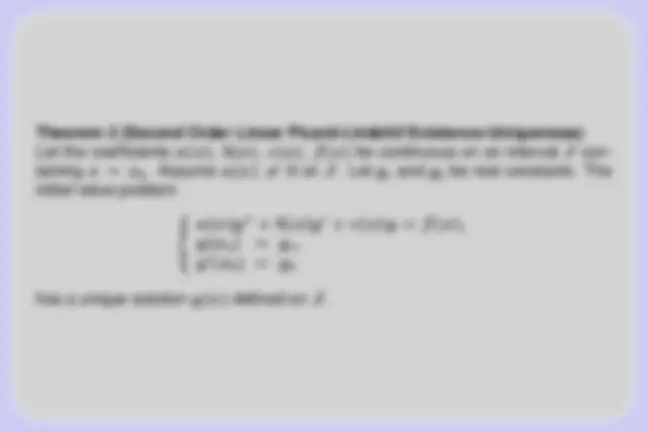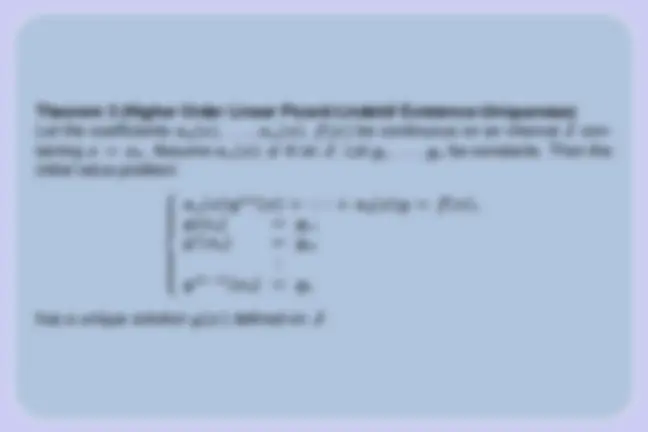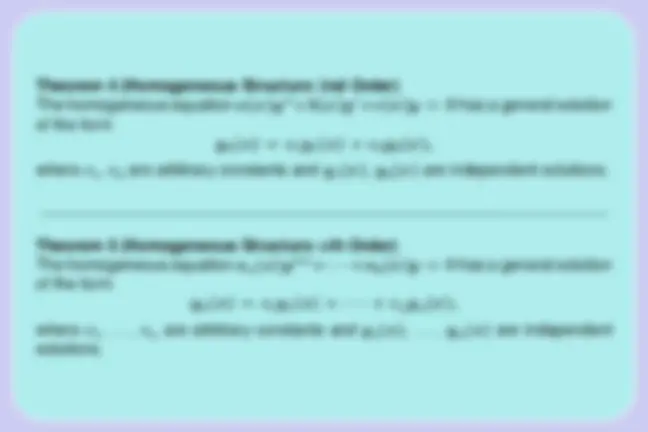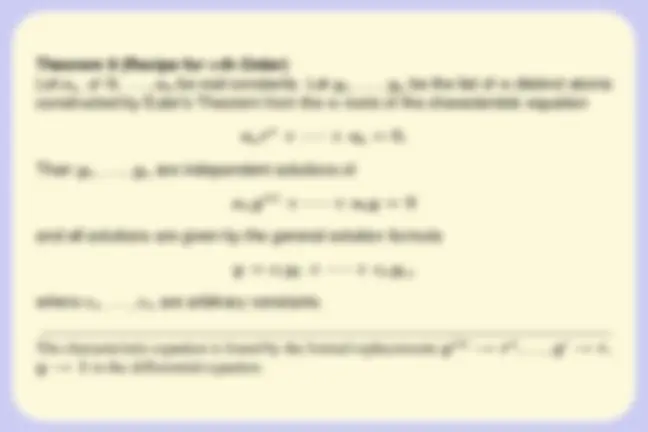









Study with the several resources on Docsity

Earn points by helping other students or get them with a premium plan


Prepare for your exams
Study with the several resources on Docsity

Earn points to download
Earn points by helping other students or get them with a premium plan
Community
Ask the community for help and clear up your study doubts
Discover the best universities in your country according to Docsity users
Free resources
Download our free guides on studying techniques, anxiety management strategies, and thesis advice from Docsity tutors
An overview of the Picard-Lindelöf existence-uniqueness theorem for linear differential equations, including the vector nth order theorem, second order linear theorem, and higher order linear theorem. It also covers homogeneous structures, recipes for constant-coefficient linear homogeneous differential equations, superposition, and non-homogeneous structures. theorems for first and second order equations, as well as the general case for nth order equations.
Typology: Study notes
1 / 13

This page cannot be seen from the preview
Don't miss anything!








Basic Theory of Linear Differential Equations
Theorem 1 (Picard-Lindel ¨of Existence-Uniqueness)
Let the n-vector function f (x, y) be continuous for real x satisfying |x − x 0
| ≤ a
and for all vectors y in R
n satisfying ‖y − y 0
‖ ≤ b. Additionally, assume that
∂f /∂y is continuous on this domain. Then the initial value problem
y
′ = f (x, y),
y(x 0 ) = y 0
has a unique solution y(x) defined on |x − x 0 | ≤ h, satisfying ‖y − y 0 ‖ ≤ b,
for some constant h, 0 < h < a.
The unique solution can be written in terms of the Picard Iterates
yn+1(x) = y 0 +
∫ x
x 0
f (t, yn(t))dt, y 0 (x) ≡ y 0 ,
as the formula
y(x) = yn(x) + Rn(x), lim n→∞
Rn(x) = 0.
The formula means y(x) can be computed as the iterate yn(x) for large n.
Theorem 3 (Higher Order Linear Picard-Lindel ¨of Existence-Uniqueness)
Let the coefficients a 0
(x),... , a n
(x), f (x) be continuous on an interval J con-
taining x = x 0. Assume an(x) 6 = 0 on J. Let g 1 ,... , gn be constants. Then the
initial value problem
a n
(x)y
(n) (x) + · · · + a 0
(x)y = f (x),
y(x 0
) = g 1
y
′ (x 0
) = g 2
. . .
y
(n−1) (x 0 ) = gn
has a unique solution y(x) defined on J.
Theorem 4 (Homogeneous Structure 2 nd Order)
The homogeneous equation a(x)y
′′ +b(x)y
′ +c(x)y = 0 has a general solution
of the form
yh(x) = c 1 y 1 (x) + c 2 y 2 (x),
where c 1
, c 2
are arbitrary constants and y 1
(x), y 2
(x) are independent solutions.
Theorem 5 (Homogeneous Structure n th Order)
The homogeneous equation a n
(x)y
(n) +· · ·+a 0
(x)y = 0 has a general solution
of the form
y h
(x) = c 1
y 1
(x) + · · · + c n
y n
(x),
where c 1
,... , c n
are arbitrary constants and y 1
(x),... , y n
(x) are independent
solutions.
Theorem 7 (Second Order Recipe)
Let a 6 = 0, b and c be real constant. Then the general solution of
ay
′′
′
is given by the expression y = c 1
y 1
y 2
, where c 1
, c 2
are arbitrary constants
and y 1 , y 2 are two atoms constructed as outlined below from the roots of the
characteristic equation
ar
2
The characteristic equation ar
2
y
′′ → r
2 , y
′ → r, y → 1 in the differential equation ay
′′
′
Construction of Atoms for Second Order
The atom construction from the roots r 1
, r 2
of ar
2
theorem below, organized by the sign of the discriminant D = b
2 − 4 ac.
D > 0 (Real distinct roots r 1
= r 2
) y 1
= e
r 1 x , y 2
= e
r 2 x .
D = 0 (Real equal roots r 1 = r 2 ) y 1 = e
r 1 x , y 2 = xe
r 1 x .
D < 0 (Conjugate roots r 1 = r 2 = α + iβ ) y 1 = e
αx cos(βx),
y 2 = e
αx sin(βx).
Theorem 8 (Euler’s Theorem)
The atom y = x
k e
αx cos βx is a solution of ay
′′
′
if r 1 = α + iβ is a root of the characteristic equation ar
2
(r − r 1
k divides ar
2
Valid also for sin βx when β > 0. Always, β ≥ 0. For second order, only k = 1, 2 are possible.
Euler’s theorem is valid for any order differential equation: replace the equation by any
(n)
and the characteristic equation by anr
n
Theorem 10 (Superposition)
The homogeneous equation a(x)y
′′ +b(x)y
′ +c(x)y = 0 has the superposition
property:
If y 1
, y 2
are solutions and c 1
, c 2
are constants, then the combination
y(x) = c 1
y 1
(x) + c 2
y 2
(x) is a solution.
The result implies that linear combinations of solutions are also solutions.
The theorem applies as well to an nth order linear homogeneous differential equation with continuous coeffi-
cients a 0 (x),... , an(x).
The result can be extended to more than two solutions. If y 1 ,... , yk are solutions of the differential equation,
then all linear combinations of these solutions are also solutions.
The solution space of a linear homogeneous nth order linear differential equation is a subspace S of the vector
space V of all functions on the common domain J of continuity of the coefficients.
Theorem 11 (Non-Homogeneous Structure 2 nd Order)
The non-homogeneous equation a(x)y
′′
′
solution
y(x) = y h
(x) + y p
(x),
where
(x) is the general solution of the homogeneous equation
a(x)y
′′
′
(x) is a particular solution of the nonhomogeneous equation
a(x)y
′′
′
The theorem is valid for higher order equations: the general solution of the non-homogeneous equation is
y = yh + yp, where yh is the general solution of the homogeneous equation and yp is any particular solution
of the non-homogeneous equation.
An Example
For equation y
′′ − y = 10, the homogeneous equation y
′′ − y = 0 has general solution yh = c 1 e
x
−x .
Select yp = − 10 , an equilibrium solution. Then y = yh + yp = c 1 e
x
−x − 10.